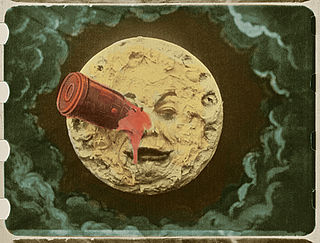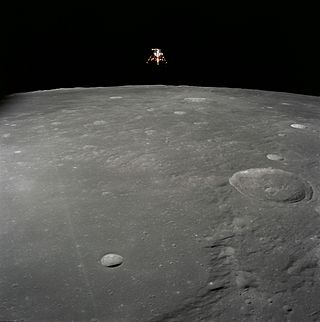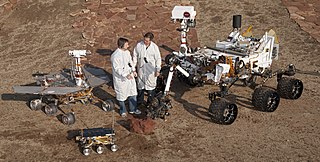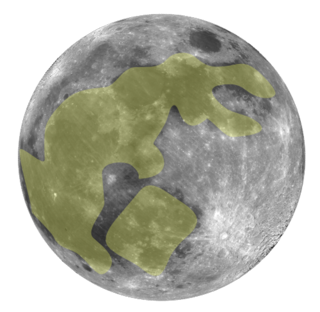
Mare Imbrium is a vast lava plain within the Imbrium Basin on the Moon and is one of the larger craters in the Solar System. The Imbrium Basin formed from the collision of a proto-planet during the Late Heavy Bombardment. Basaltic lava later flooded the giant crater to form the flat volcanic plain seen today. The basin's age has been estimated using uranium–lead dating methods to approximately 3.9 billion years ago, and the diameter of the impactor has been estimated to be 250 ± 25 km. The Moon's maria have fewer features than other areas of the Moon because molten lava pooled in the craters and formed a relatively smooth surface. Mare Imbrium is not as flat as it would have originally been when it first formed as a result of later events that have altered its surface.

In many cultures, several pareidolic images of a human face, head or body are recognized in the disc of the full moon; they are generally known as the Man in the Moon. The images are based on the appearance of the dark areas and the lighter-colored highlands of the lunar surface.

The Mid-Autumn Festival is a harvest festival celebrated in Chinese culture. It is held on the 15th day of the 8th month of the Chinese lunisolar calendar with a full moon at night, corresponding to mid-September to early October of the Gregorian calendar. On this day, the Chinese believe that the moon is at its brightest and fullest size, coinciding with harvest time in the middle of autumn.

Chang'e, originally known as Heng'e (姮娥), is the goddess of the Moon and wife of Hou Yi, the great archer. Renowned by her beauty, Chang'e is also known for her ascending to the Moon with her pet Yu Tu, the Moon Rabbit and living in the Moon Palace (廣寒宮). She is one of the major goddesses in Chinese mythology, Chinese folk religion, Chinese Buddhism, Confucianism, and Taoism. In modern times, Chang'e is the namesake of the Chinese Lunar Exploration Program.

The far side of the Moon is the lunar hemisphere that always faces away from Earth, opposite to the near side, because of synchronous rotation in the Moon's orbit. Compared to the near side, the far side's terrain is rugged, with a multitude of impact craters and relatively few flat and dark lunar maria ("seas"), giving it an appearance closer to other barren places in the Solar System such as Mercury and Callisto. It has one of the largest craters in the Solar System, the South Pole–Aitken basin. The hemisphere has sometimes been called the "Dark side of the Moon", where "dark" means "unknown" instead of "lacking sunlight" – each location on the Moon experiences two weeks of sunlight while the opposite location experiences night.

A Moon landing or lunar landing is the arrival of a spacecraft on the surface of the Moon, including both crewed and robotic missions. The first human-made object to touch the Moon was Luna 2 in 1959.

A lunar lander or Moon lander is a spacecraft designed to land on the surface of the Moon. As of 2024, the Apollo Lunar Module is the only lunar lander to have ever been used in human spaceflight, completing six lunar landings from 1969 to 1972 during the United States' Apollo Program. Several robotic landers have reached the surface, and some have returned samples to Earth.

The physical exploration of the Moon began when Luna 2, a space probe launched by the Soviet Union, made a deliberate impact on the surface of the Moon on September 14, 1959. Prior to that the only available means of lunar exploration had been observations from Earth. The invention of the optical telescope brought about the first leap in the quality of lunar observations. Galileo Galilei is generally credited as the first person to use a telescope for astronomical purposes, having made his own telescope in 1609, the mountains and craters on the lunar surface were among his first observations using it.

A rover is a planetary surface exploration device designed to move over the rough surface of a planet or other planetary mass celestial bodies. Some rovers have been designed as land vehicles to transport members of a human spaceflight crew; others have been partially or fully autonomous robots. Rovers are typically created to land on another planet via a lander-style spacecraft, tasked to collect information about the terrain, and to take crust samples such as dust, soil, rocks, and even liquids. They are essential tools in space exploration.

The Moon rabbit or Moon hare is a mythical figure in East Asian and indigenous American folklore, based on interpretations that identify the dark markings on the near side of the Moon as a rabbit or hare. In East Asian mythology, the rabbit is seen as pounding with a mortar and pestle, but the contents of the mortar differ among Chinese, Japanese, Korean, and Vietnamese folklore. In Chinese folklore, the rabbit is often portrayed as a companion of the Moon goddess Chang'e, constantly pounding the elixir of life for her and some show the making of cakes or rice cakes; but in Japanese and Korean versions, the rabbit is pounding the ingredients for mochi or tteok or some other type of rice cakes; in the Vietnamese version, the Moon rabbit often appears with Hằng Nga and Chú Cuội, and like the Chinese version, the Vietnamese Moon rabbit also pounding the elixir of immortality in the mortar. In some Chinese versions, the rabbit pounds medicine for the mortals and some include making of mooncakes. Moon folklore from certain Amerindian cultures of North America also has rabbit themes and characters.

A lunar rover or Moon rover is a space exploration vehicle designed to move across the surface of the Moon. The Apollo program's Lunar Roving Vehicle was driven on the Moon by members of three American crews, Apollo 15, 16, and 17. Other rovers have been partially or fully autonomous robots, such as the Soviet Union's Lunokhods, Chinese Yutus, Indian Pragyan, and Japan's LEVs. Five countries have had operating rovers on the Moon: the Soviet Union, the United States, China, India, and Japan.

Yutu was a robotic lunar rover that formed part of the Chinese Chang'e 3 mission to the Moon. It was launched at 17:30 UTC on 1 December 2013, and reached the Moon's surface on 14 December 2013. The mission marks the first soft landing on the Moon since 1976 and the first rover to operate there since the Soviet Lunokhod 2 ceased operations on 11 May 1973.

Chang'e 6 was the sixth robotic lunar exploration mission by the China National Space Administration (CNSA) and the second CNSA lunar sample-return mission. Like its predecessors in the Chinese Lunar Exploration Program, the spacecraft is named after the Chinese moon goddess Chang'e. It was the first lunar mission to retrieve samples from the far side of the Moon; all previous samples were collected from the near side.
The following outline is provided as an overview of and topical guide to the Moon:

So far, the year saw the successful first launch of Vulcan Centaur, Gravity-1, Ariane 6, and notably more developmental launches of SpaceX's Starship. Additionally, the final launch of a Delta family rocket occurred in April with a Delta IV Heavy. In May, China launched the Chang'e 6, the first sample return from the far side of the Moon. The Polaris Dawn mission conducted the first ever commercial spacewalk in September.

Yutu-2 is the robotic lunar rover component of CNSA's Chang'e 4 mission to the Moon, launched on 7 December 2018 18:23 UTC, it entered lunar orbit on 12 December 2018 before making the first soft landing on the far side of the Moon on 3 January 2019. Yutu-2 is currently operational as the longest-lived lunar rover after it eclipsed the previous lunar longevity record of 321 Earth days held by Soviet Union's Lunokhod 1 rover. Yutu-2 is the first lunar rover ever to have traversed the far side of the Moon. By January 2022, it had travelled a distance of more than 1,000 metres (3,300 ft) along the Moon's surface. Data from its ground penetrating radar (GPR) has been used by scientists to put together imagery of multiple layers deep beneath the surface of the far side of the Moon. As of September 2024, the Yutu-2 was still active.


















